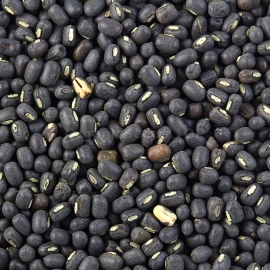 EXCLUSIVE
EXCLUSIVE
Organic Black Gram Seeds (Vigna Mungo)
1.39 €
Vigna mungo or also known in various common names such as Black Gram, Urd Bean, Black Matpe, and Black Mung Bean, is an erect, hairy, and bushy annual plant with a well-developed tap root and grows up to 100 cm in height.
-
Organic Black Gram / Vigna Mungo
Vigna mungo or also known in various common names such as Black Gram, Urd Bean, Black Matpe, and Black Mung Bean, is an erect, hairy, and bushy annual plant with a well-developed tap root and grows up to 100 cm in height.
It is often grown in the Indian subcontinent. The pods are narrow and cylindrical with each pod containing about 4-10 small, black seeds. The leaves are composed of three oval leaflets each. Flowers are yellow and in dense clusters. Young seedpods and seeds are cooked and consumed as a vegetables.
Dried seeds are boiled or ground into flour. The leaves are also edible. In traditional medicine, the seeds are used as a poultice on abscesses. Seed flour is rich in saponins and can be used as a substitute to soap. The plant has the ability to fix atmospheric nitrogen hence it is grown in some areas as green manure.
Cultivation details
A plant of the drier tropics, where it is found at elevations up to 2,000 metres. It grows best in areas where annual daytime temperatures are within the range 22-35С, but can tolerate 8-40С. The plant does not tolerate frost. It prefers a mean annual rainfall in the range 650-900mm, but tolerates 530-2,430mm. Rain at flowering time has a very adverse effect upon seed yields. Plants are not adapted to wet, humid areas with high rainfall, but can, however, be grown in the dry season of wetter areas so long as this is at least 4 months in duration.
Requires a sunny position. Grows well in well-drained, fairly heavy fertile soils. Tolerant of moderate levels of salt in the soil. Prefers a pH in the range 5.5-6.5, tolerating 4.5-7.5. Established plants are drought resistant. Immature pods can be harvested about 60-80 days after sowing. Mature beans can be harvested after 75-130 days. Yields of 500-650 kilos per hectare of dried seeds can be obtained. The average yield of dry seeds in India can vary between 340-1,500 kilos per hectare.
There are some named varieties. There are three main forms of this plant:- Var mungo. A large seeded, early maturing form with black seeds. Var viridis Bose. A small seeded late maturing form with brown, green or grey seeds. Ver silvestris Lukoki, Marchal & Otoul. The original, wild form. Most cultivars require short daylengths.
This species has a symbiotic relationship with certain soil bacteria, these bacteria form nodules on the roots and fix atmospheric nitrogen. Some of this nitrogen is utilized by the growing plant but some can also be used by other plants growing nearby. When removing plant remains at the end of the growing season, it is best to only remove the aerial parts of the plant, leaving the roots in the ground to decay and release their nitrogen.
